|
What a wealth of wonderful music awaits early music enthusiasts in the polyphonic music of the mid-fifteenth to sixteenth centuries. The masses, motets, and other pieces composed for sacred
services, along with a wide range of secular forms, offer us an almost limitless repertoire by the finest composers in one of music's finest hours. Further, while they are musically complex and fascinating in their
exposition of rhythm and melody, they are technically within the abilities of a wide range of singers and players. Consequently, we have the best of both worlds: great music that we can really play! The
Art of the Netherlands Series draws from this musical treasure-trove. While not all of the composers represented in this series actually lived in the Netherlands (Ludwig Senfl, for example), they are all composers who
wrote music in the beautiful and unmistakable Flemish style. 
Josquin des Prez.
Ave Maria (SATB or SA/sTTT/bB) LP ANS-1
Set for Recorders or Viols by LaNoue Davenport. $12.50
 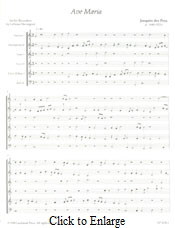
This famous motet, by the premier composer of the period, was first written in four parts then later
the composer added two more to make it a six-part motet. This edition includes, in one score, the four-part original (Soprano I, Tenor I, Tenor II, Bass II), and the six-part gloss on that piece with
the addition of Alto/Soprano II, and Tenor III/Bass 1. The piece can be played either way—just the four-part original, or the six-part version. We have also published the piece with no bar-lines as an
introduction to this common practice of the period (and in accordance with my father's strongly held beliefs to do so). LaNoue believed that of all the differences between renaissance notation and that
of the present day, the bar-line was the most important. "The 'tyranny of the bar-line' has a most profound effect on the performance of renaissance music, since it organizes melodic structure in a
way that was not necessarily indicative of the composer's intentions (with regular strong beats occurring at pre-set intervals of time). With no bar-line intervening with its strength, medieval and
renaissance composers were free to write melodic structures of varying, often uneven lengths." "Josquin's Ave Maria, edited by LaNoue Davenport, is a gorgeous piece, imitative from start
to finish. The independence of parts and the characteristic Netherlandish syncopations require solid rhythmic skills—particularly since this edition has occasional rehearsal marks
but no bar-lines! Reading this piece will be good practice for players who are almost (but not quite) ready to read from facsimiles." (Stewart Carter, American Recorder) 
Ludwig Senfl. Missa Paschalis (SSATB or TrTrTTB) LP ANS-2
Set for Recorders or Viols by LaNoue Davenport. $26.00
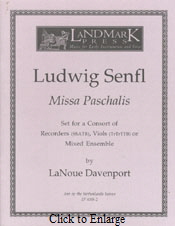 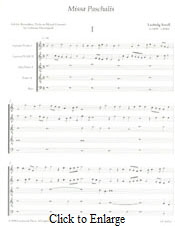
When Ludwig Senfl was alive, the extraordinary period of sixteenth-century polyphony was in its
prime and Senfl was one of the eras most remarkable practitioners. His settings for the Catholic Mass are among the best. He also completed a number of settings of the mass Proper begun by his
predecessor, Heinrich Isaac, but left unfinished at Isaac's death. Despite these accomplishments Senfl was thought to be a "closet Protestant," much influenced by Luther's writings and teachings.
This edition is not meant for any liturgical function but rather for instrumental performance as an abstract work. Thus, numbers are assigned to the movements and text is omitted with the performer
relying on cohesion through the melodic phrasing and cadential formulas inherent in the composition. These pieces sound equally well played on five recorders, five viols, or a mixture of the two. "
Senfl's Missa Paschalis is thoroughly contrapuntal and there is quite a bit of syncopation. The music is vintage Senfl—absolutely gorgeous and well worth the effort of learning it." (Stewart Carter,
American Recorder) 
Nicolas Gombert. Dezilde al Cavallero
(AATT/bB or TrTrTTB) LP ANS-3 Transcribed and Edited for Voices, Recorders, Viols or Other Early Instruments
by Mark Davenport. $12.00
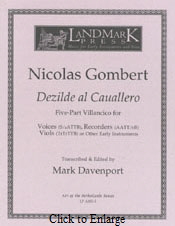 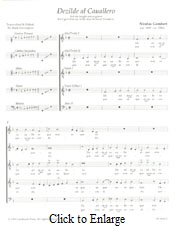
Nicolas Gombert (ca. 1495 - ca. 1556) is a product of the High Renaissance, a probable student of
Josquin, and a contemporary of Adrian Willaert, Cristbal de Morales, and Ludwig Senfl. Gombert is truly a cosmopolitan composer who, as master of choirboys in the chapel of Emperor Charles V,
traveled extensively as an official member of court. Gombert is known to have worked in such cities as Vienna, Brussels, and Madrid. Perhaps it was during his travels in Spain that Gombert was
inspired to compose this beautiful villancico. Actually, the piece appears to have the distinction of being the only Spanish song written by Gombert (among more than 70 French chansons found in his
complete works). Yet, Gombert's lone example stands as one of the most aesthetically engaging of the genre. "
A beautiful, finely crafted piece with plenty of imitation, it will require musicians who can count, though the parts are not technically demanding. Since Mark Davenport has underlaid
the text, the piece can be sung as well as played. The editor provides thematic incipits, range finders, a translation of the text, performance suggestions, and notes on the edition. This
publication is a model of sensible editing." (Stewart Carter, American Recorder) |